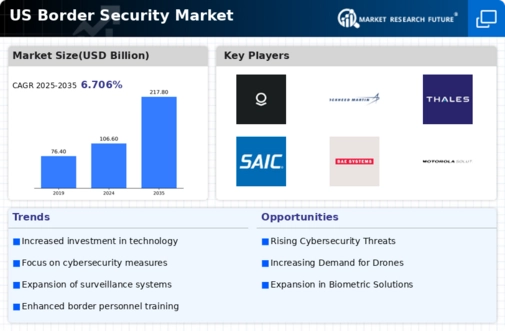Increased Security Threats
The border security market is experiencing heightened demand due to the rising frequency and sophistication of security threats. This includes terrorism, drug trafficking, and human smuggling, which have prompted the U.S. government to invest heavily in advanced security measures. In 2025, the federal budget allocated approximately $25 billion to border security initiatives, reflecting a 10% increase from the previous year. This surge in funding indicates a proactive approach to addressing emerging threats, thereby driving growth in the border security market. Enhanced surveillance technologies, such as drones and biometric systems, are being integrated to bolster security measures. As threats evolve, the border security market is likely to expand to meet the challenges posed by these complex security dynamics.
Technological Advancements
Technological advancements play a pivotal role in shaping the border security market. Innovations in surveillance, detection, and communication technologies are transforming how borders are monitored and secured. For instance, the adoption of artificial intelligence (AI) and machine learning algorithms is enhancing threat detection capabilities, allowing for real-time analysis of data collected from various sources. In 2025, the market for border security technology is projected to reach $30 billion, with a compound annual growth rate (CAGR) of 8% over the next five years. This growth is driven by the need for more efficient and effective security solutions. The integration of advanced technologies improves operational efficiency and reduces response times to potential threats, reinforcing the overall security framework.
Public Awareness and Support
Public awareness and support for border security measures are crucial drivers of the border security market. As citizens become more informed about security issues, there is a growing demand for enhanced border protection. In 2025, surveys indicate that approximately 70% of the U.S. population supports increased funding for border security initiatives. This public backing encourages policymakers to allocate resources towards advanced security technologies and infrastructure improvements. The border security market is likely to benefit from this heightened awareness, as it creates a conducive environment for investment and innovation. Furthermore, public support can lead to the establishment of partnerships between government agencies and private sector entities, fostering collaboration that enhances overall security effectiveness.
Government Policy Initiatives
Government policy initiatives significantly influence the border security market. Legislative measures aimed at enhancing national security have led to increased funding and support for border security programs. In 2025, new policies are expected to be introduced that focus on modernizing border infrastructure and improving inter-agency collaboration. These initiatives may include the establishment of task forces dedicated to addressing specific security challenges, which could further stimulate investment in the border security market. This indicates a long-term commitment to safeguarding national interests and creates a favorable environment for market growth. As policies evolve, they are likely to shape the direction and priorities of the border security market.
International Relations and Trade Policies
International relations and trade policies have a profound impact on the border security market. As the U.S. engages in trade agreements and diplomatic negotiations, the need for robust border security measures becomes increasingly apparent. In 2025, trade policies that emphasize security cooperation with neighboring countries are expected to influence the border security market. Enhanced collaboration may lead to joint initiatives aimed at addressing cross-border security challenges, thereby driving investment in security technologies. The border security market is likely to grow as countries collaborate to streamline processes and ensure safety. This interconnectedness highlights the importance of border security in facilitating trade and maintaining national security.




















Leave a Comment